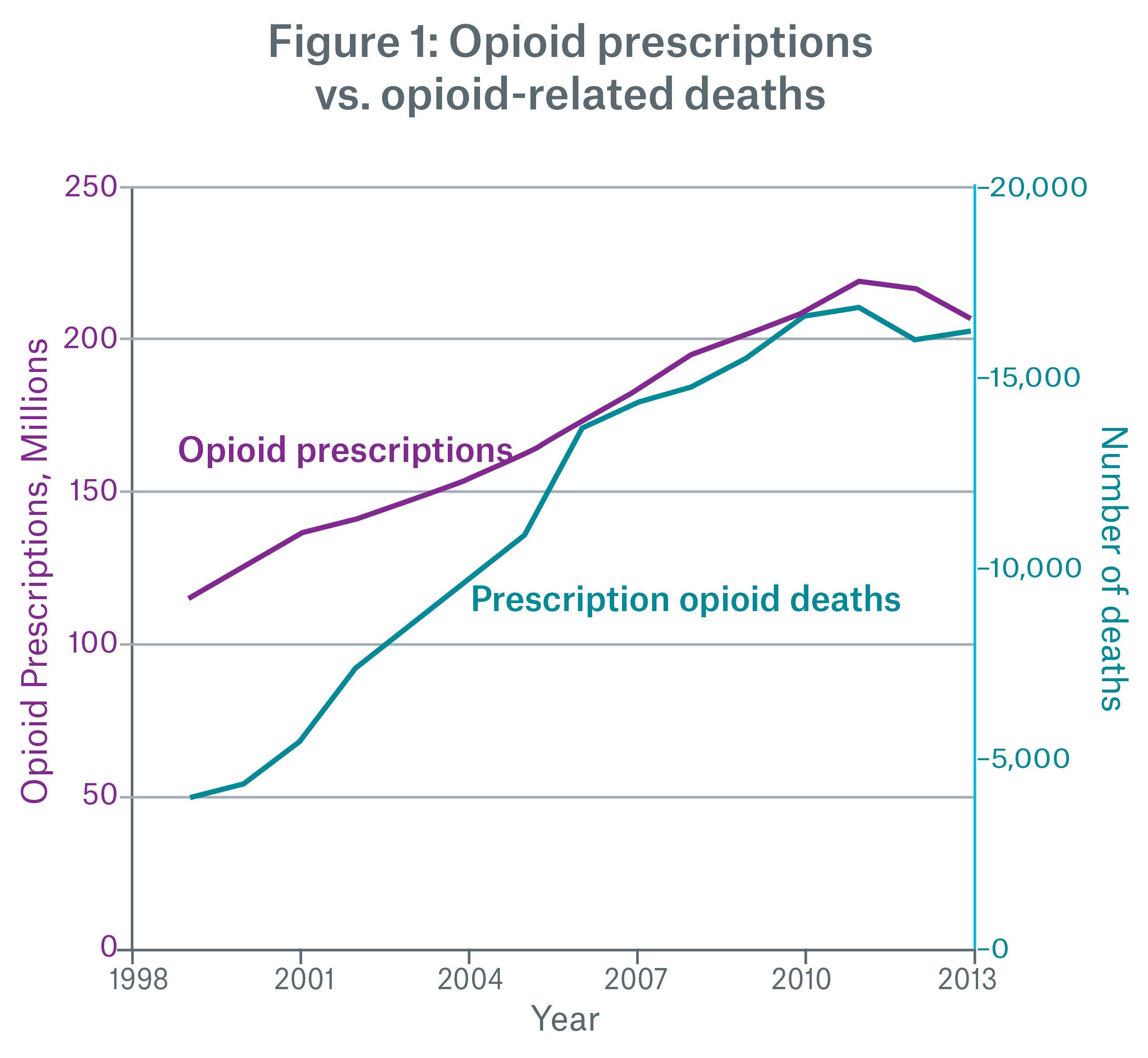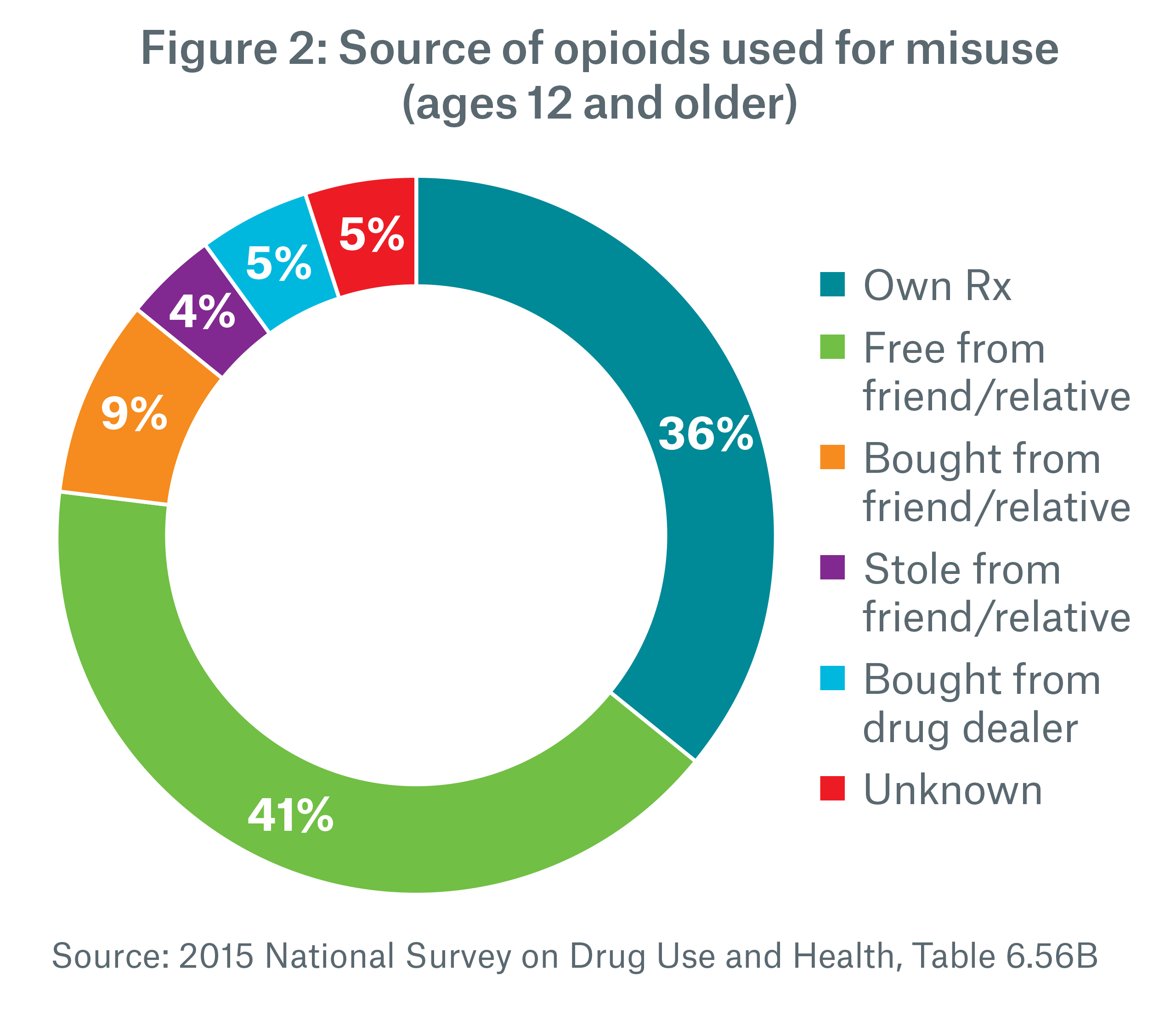
A highly respected, if unorthodox, physician in his mid-30s injures his leg while playing golf. When the pain continues, doctors discover severe muscle tissue damage due to compromised circulation. The physician undergoes multiple surgical treatments with a difficult recovery. He is prescribed the opioid narcotic pain killer Vicodin (acetaminophen and hydrocodone), but the pain never really goes away. Over time, he needs more and more of the drugs in order to cope with his chronic pain as well as the stresses of a demanding life. Does this sound familiar? The popular television character, Dr. Gregory House, reveals a common journey to opioid addiction, beginning with a legitimate medical need for pain management that grew into tolerance, dependency and addiction.
The current opioid epidemic is well-publicized, and its size and scope documented in both mainstream and medical literature. This paper seeks to understand the unique set of circumstances that led to the dramatic rise in opioid prescriptions over the last few decades, and provide a brief overview of the resultant morbidity and mortality for the insured population. Subsequent papers will provide a deeper look at opioid mortality, as well as a perspective on treatment of opioid addiction, the changing face of heroin use in the U.S., and alternative therapies for chronic pain, among other topics.

Catalysts for the opioid epidemic
Prior to the mid-1990s, physicians typically treated pain when it was severe, such as from cancer, surgery or trauma, and typically in acute-care settings, such as hospitals. In the middle of the decade, attitudes towards pain and pain relief began to change. It was believed that clinicians generally failed to assess pain and provide adequate relief, since pain is both subjective and multidimensional. One medical group even launched a campaign encouraging pain to be considered the fifth vital sign (along with pulse, blood pressure, respiration and temperature).
At the same time as this increased focus on alleviating all types of pain, new time-release opioid formularies began to appear on the market claiming to be nearly addiction-proof and that their steady 12-hour coverage would avoid withdrawal. This combination sparked a rapid rise in the amount of prescription opioids sold in the U.S.
Narcotics were no longer recommended only in the case of extreme pain, e.g., severe cancer pain, but became routinely prescribed by general physicians for all types of pain including low back pain, migraine headaches, muscle aches, etc. Strong medications to alleviate chronic pain became more commonplace in less supervised settings. Since 1999, the amount of prescription opioids sold annually in the U.S. has nearly quadrupled.1
Physicians were actively managing pain and it seemed the overall failure to assess pain and provide pain relief was subsiding. However, the increased use of opioids has a dark side. Over the past several decades, the increase in opioid prescribing has been associated with serious risks, including opioid use disorder, diversion, addiction, and overdose deaths.
An opiate is a drug containing opium or its derivatives used in medicine for inducing sleep and relieving pain. It is considered a narcotic, which is a class of drugs that dulls the senses, relieves pain, causes drowsiness, and, in moderate doses, even profound stupor or coma. Opiates, originally derived from the poppy plant, have been around for thousands of years. Starting in the early 20th century, the U.S. government has taken several steps to restrict the general distribution of opium/opiates. The Controlled Substances Act of 1970, which classified drugs into five categories based on abuse potential and clinical usefulness, and the creation of the Drug Enforcement Agency in 1973, were efforts to curtail drug use, addiction and illegal sales.
The rise of morbidity and mortality
The 2015 National Survey on Drug Use and Health estimated that approximately 97.5 million U.S. adults had taken some type of pharmaceutical opioid in the past year. More than 12 million (12 percent of those users) were estimated as misusing the opioid in a non-prescribed manner, while two million Americans (2 percent of users) fulfilled the criteria for opioid use disorder.2
Although these statistics indicate that a great majority of patients prescribed opioids do not go on to develop dependency or addiction, the rapid growth rate in, and absolute numbers of, adverse effects are very concern-ing. With the rise in opioid prescriptions, deaths from prescription opioids — drugs like oxycodone, hydro-codone, and methadone — have more than quadrupled since 1999 (see Figure 1).3 In 2015, 61 percent of drug overdose deaths involved an opioid.4 Opioid-related inpatient stays and emergency department visits related to opioids are also on the rise.5 Opioid use and addiction have increased in parallel to one another with as many as one in four people taking long term prescription opioids in a primary care setting struggling with addiction.6
Another concern is that pain management practices don’t appear to have been truly effective over this timeframe. An estimated one out of five patients with non-cancer pain, or pain-related diagnoses, are prescribed opioids in office-based settings7, yet there has not been an overall change in the amount of pain that Americans report.7,8
Turning the tide
In response to the increasing use of opioid medications and the worsening trends in opioid addiction, morbidity, and mortality, the Centers for Disease Control and Prevention (CDC) and the U.S. Department of Veterans Affairs/U.S. Department of Defense published new guidelines for primary care physicians regarding the proper use of opioids in the management of non-cancer-related chronic pain. These guidelines provide guidance in three critical areas:
- When physicians should begin, or continue, to prescribe opioids for chronic pain.
- Which drugs should be used, along with dosage, duration, follow-up, and plans for discontinuation.
- How to assess the risk for, and harms of, opioid use.
These guidelines are moving clinicians in the right direction in the fight to curb the current opioid epidemic. In August 2016, U.S. Surgeon General, Vivek H. Murthy, MD., asked physicians to make a commitment to turn the tide on the opioid crisis (www.turnthetiderx.org). The effectiveness of increased awareness, better prescribing patterns, comprehensive multi-modal treatments, and alternative pain treatments is beginning to be reflected in fewer opioid prescriptions (Figure 1).

Insurance considerations
In the meantime, as insurers, we need to be aware that the opioid epidemic is not limited to a single socioeconomic group or geographic region. As described in the “House” example, opioid addiction can affect those who are our prime insurance candidates. It is interesting that more than half of misused opioids (54%) are likely to have been diverted from legitimate prescriptions from a friend or relative (Figure 2).9 As mentioned above, up to one quarter of individuals receiving long term opioid therapy in a primary care setting struggle with addiction.3
Once addicted, it can be very hard to stop using.
There are several risk factors for prescription opioid abuse and overdose to be aware of when evaluating insurance applicants. The most notable include: 9,10
- Overlapping prescriptions from multiple prescribing doctors and pharmacies.
- High daily dosages.
- Mental illness or a history of alcohol or other substance abuse.

Conclusion
Pain remains a common subjective complaint for many individuals seen in primary care settings. Especially in the case of chronic pain, physicians and patients need to work together to achieve a good quality of life. This may not mean a complete absence of pain, but rather the right balance between reducing pain while also reducing the risk for adverse consequences such as opioid overuse, narcotics addiction, and death. Achieving this goal in appropriate pain management is more complex than prescribing medications alone.
Life and disability insurers need to be aware of the current rise in morbidity and mortality related to opioid use. While some progress appears to have been made, the current opioid epidemic is not likely to disappear overnight. Insurers need to be aware that opioid addiction is not limited to particular socioeconomic groups or geographic locations and understand the potential morbidity and mortality consequences of opioid addiction related to those applying for coverage in order to underwrite them appropriately.
Contact the Author:
/Gina%20Guzman.jpg/_jcr_content/renditions/original./Gina%20Guzman.jpg)
Newsletter
properties.trackTitle
properties.trackSubtitle